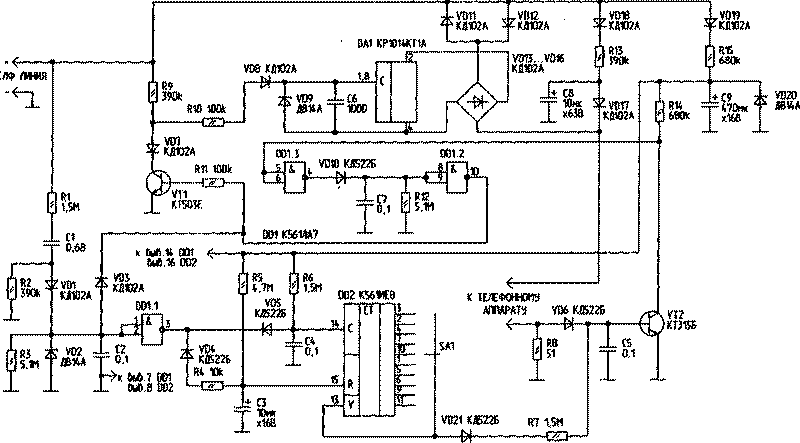In the operation of the telephone apparatus, it is sometimes necessary selection number of call signals (calls) that come on the phone. The circuit shown in the figure, you will have to implement the "incoming" selection of packages call from a PBX.
Unlike the motion detector [1], the device is powered from the telephone line and almost 100% suppresses the necessary calls.
In the console enter:
- input node for receiving and processing parcels call on DD1.1, R1-R3, C1, C2, C4, VD1, VD2...VD5;
- counter of number of calls - DD2;
key connect your phone to the line - DA1, VD13...VD16;
node lift tube VT1, VT2, R8, R14, VD6, C5, DD1.2,DD1.3;
- the batteries 60B-VD17,VD18,R13,C8; 8B-VD19.VD20.R15, C9;
- selector switch calls - SA1.
In the initial state on-hook, R8 no voltage drop, resulting VT2 is closed, and through the elements of DD1.3, DD1.2 (a logical "1" output 10 DD1.2) supported an open state VT1. The key DA1 is closed, and the bridge VD13...VD16 disconnects the telephone from the telephone line. In this state, the upper circuit output telephone device is energized 40...60 V through a chain VD18, R13, C8, VD17. Assume that the switch SA1 is connected to pin 10 of the counter DD2. When you receive a call from the PBX it does not pass directly to the phone and processed DD1.1 and sequentially switches the counter DD2.

After the fourth call high level output 10 DD2 through VD21, R7 opens the transistor VT2 and thereby through DD1.3, DD1.2, VT1 key opens the DA1. Phone through the open bridge VD13...VD16 connects to the line and starts to call the fifth call. At the same time through VD3 is locked to the input node DD1.1.
Changing the position SA1, you can adjust the number of missed calls. When connecting SA1 to the conclusion 3 DD2 phone is connected to the line constantly. Operation of the lifting tube is similar to that described in [2]. If you remove the tube the voltage drop across R8 VT2 and opens through DD1.3, DD1.2 locks VT1. The voltage from the line through R9, R10, VD8 opens the key DA1, bridge VD13...VD16 and connects the phone to the line. The process of picking up the handset should be considered in the dynamics, as the capacitance C8 is discharged through the outdoor phone fast enough, and if the key DA1 does not have time to open before the end of the discharge S8, the phone does not connect to the line. The time required for opening DA1 provides chain VD10, R12, C7, which is charged very quickly, and is discharged around 1 s. this is Usually enough for a steady connect the telephone to the line. Next is the line voltage through an open phone supports across the resistor R8, you need a voltage higher than 0.8 V, which holds VT2 in the open state. During dialing chain VD6, C5, and VD10, R12, C7, and VD8, VD9, C6't allow you to disable the phone from the line.
If the tube is put more than 1, the circuit returns to its original state. This device can be used as a "night" of the phone when the first 5...6 calls are ignored and the call will only subscriber that knows that the tube will be removed after 6...7 call.
Another possibility is to use the device-selector - prioritization of call in two parallel devices located in different rooms. In this case one of the devices is connected through the console selector. When you receive a call alert ringing only one device. If the tube was not removed within a certain number of rings, begins to ring and the second device. The result is a kind of prefix "Director / Secretary. Apply a prefix can be any type of PBX with a nominal voltage of station batteries 48...60 V and unchanging polarity when connecting.
Besides these consoles, the authors develop and produce adapters coupled lines, blocks protect against parallel "pirate" connections, splitters rooms, blockers "long distance" and the parallel phone. All devices are powered from the telephone line.
Literature
1. Evseev, A. Consoles to telephones. To help radio Amateurs: the Collection. Vol.112. - M.: The Patriot, 1991.-Pp. 28-36.
2. The DRK A., Balakhnichev I. Micro-PBX. Hams.- 1996.- No. 6.-C. 20-21.
Authors: A. Drike, I. Balakhnichev; Publication: N. Bolshakov, rf.atnn.ru






